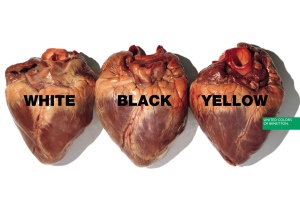If anyone ever needs an image to define the word “taboo” or “controversy, I think this would be it.
This ad begins to apply cultural or religious rhetoric that evokes issues of values, judgments and secondary stories.
I am not Christian or involved in any type of church so I might not fully understand the religious implications of this ad but I do know that this would make people upset.
As far as ad effectiveness goes, I think Benetton might have pissed more people off with this ad then even they could imagine. I can only fathom the amount of controversy that this ad stirred up, them amount of people that talked about this ad, and United Colors of Benetton. As I have learned in my marketing class, free press is good press, whether its negative or positive. It gets people talking about the company and their product. It ends up that the people who are most upset by these shocking ads give the company the most publicity. It’s a little ironic and maybe unfortunate in some cases, for those companies that really don’t deserve it, but in my opinion I think it’s a great move on Benetton’s part.
I don’t think this ad really helps their image as far as corporate rhetoric goes, or rather if it does than I think the point may be lost on a large part of their audience.
It’s important to remember who sees these ads and where they see these ads. As there are no United Colors of Benetton stores in New Mexico (I think the closest store is in Houston, TX), they have no priorities to market in this state, and which is why many people probably haven’t seen these ads in real life (maybe only in a book or somewhere on the internet as a reference for something else). What’s odd to me is that I used to live in Houston and in India (where they also have stores) and I never saw any advertising for the store, I did however see these ads in New York City. They use the huge billboards and blow these images up to monstrous proportions so they can be seen from miles away (if a building or another billboard doesn’t get in its way!).
I think it’s interesting that Benetton is so picky with the target audience that they market to. As can be seen with this ad of the priest and nun, it’s very important to think about the target audience. In a place like New York City this ad can be taken for what it is, an artistic attempt to bring up taboo social issues. In a place like Houston, with its mega churches like Lakewood Church and devout followers of Joel Osteen (who recently turned the Rockets basketball stadium into his church complete with televised services!), I think this point might be totally lost and possibly cause the store to go out of business in the area. I don’t even want to think about what would happen if this ad was somewhere along I-25 here in Albuquerque! I recently showed this ad in my marketing class and, unsurprisingly, got very few positive responses from my classmates.
All in all I think it’s important for a company to pick a stance and stick to it, unless of course its not working at all, then they might want to consider repositioning. Otherwise it says a lot about the strength and power of a company that can show an ad like this (and this isn’t even the worst!) and still continue to gain market share every year. Benetton is currently Italy’s largest clothing manufacturer and the company is going strong on 42 years of business with no signs of slowing down or backing off. At this point it doesn’t really matter whether I think the ads are effective or not, that fact alone tells the world that Benetton has found a marketing strategy that works for them.
Just a note about my sources… all of the images and information about United Colors of Benetton can be found on their corporate website http://www.benettongroup.com. They have so much information about the company, including financial statements, press releases, company history and their plans for the future on there. Other than that, I have taken information from my English 220 class on Advertising Rhetoric at University of New Mexico. To see lecture notes you can go to, http://english220.wordpress.com/
I have also taken some information from my Marketing Management 322 class also at University of New Mexico, although it was mostly what I have chosen to retain after completing the class, I have not directly quoted my teacher or my notes in this blog.
The rest of the writing is a combination of my thoughts, opinions and experiences and most of all a reflection of what I have learned about advertising rhetoric in my class.








